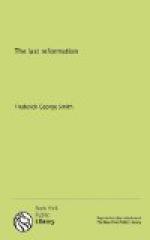It is clear that two powers in the Christian era are here represented, the one continuing “forty and two months” and the other twelve hundred and sixty days, or years, heretofore explained as measuring the length of the beast’s reign, also of the woman’s seclusion in the wilderness. This similarity naturally suggests that we have here the same general facts set forth under other symbols. Jerusalem, the holy city, the temple, and the two witnesses therefore correspond to the woman of chapter 12. The crowd of uncircumcised Gentiles and their profanation of the city of God for twelve hundred and sixty years correspond to the beast-power of chapter 13.
Wonderful truth is represented in the vision of this chapter. The symbols are drawn from Old Testament history, from the religious life of the Jews—God’s chosen people in contrast with the uncircumcised Gentiles. It is evident, therefore, that the true church and the false church of the gospel era are represented.
Notice carefully the symbols: holy city, temple, altar, worshipers, and living witnesses, or prophets. These represent the sum and substance of all divine revelation in the Mosaic age: holy city, Jerusalem—the place where God set his name; the temple—divinely authorised, holy, acceptable worship based on careful adherence to God’s commandments formerly given; the altar—the great symbol of atonement, the reconciliation of humanity with the divinity; the worshipers in one temple—all of God’s people in unity; the prophets—the divinely commissioned representatives of God bearing a living message for the people of their time. These conditions represent the Judaic ideal. Whether they were ever able to reach their ideal or not, it is evident that the Jews had the conception of a unified, holy, acceptable service (see Isa. 4:3; 52:1; 62:1-7). The two witnesses referred to are clearly represented as prophets; for the work ascribed to them as attesting their divine commission is a repetition of the miraculous works of Moses and Elijah by which they established their claims to be prophetic leaders authorized by Jehovah. The witnesses seem to be distinguished from the worshipers simply on account of their power and message.
[Sidenote: The two witnesses]
These symbols represent the true apostolic church. It is the holy city, Jerusalem, his temple, whose holy, united worshipers obey the commands of God. The application of the “witnesses” particularly specified as they are in the description, requires further explanation. It is said, “These are the two olive trees and the two candlesticks standing before the God of the earth” (Rev. 11:4). Whatever these two witnesses signify in particular, they are the same as the olive trees and candlesticks spoken of. It appears that allusion is made to Zechariah 4, where two olive trees are represented as standing, one on each side of a golden candlestick, distilling into it their oil for light. When




